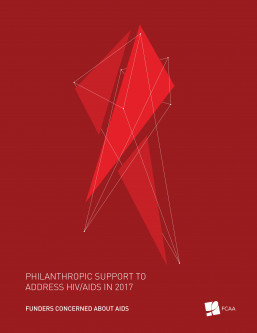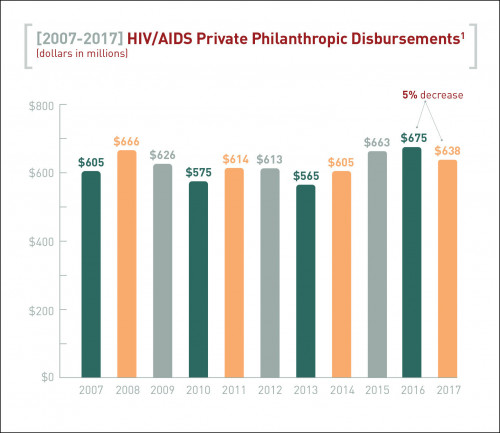Philanthropic funding to fight the global AIDS epidemic dropped 5 percent last year, compared with 2016, for a decrease of about $37 million, according to a new report from Funders Concerned About AIDS (FCAA). This includes private support from groups ranging from The Bill & Melinda Gates Foundation to pharmaceutical giant Gilead Sciences.

Cover of the reportCourtesy of Funders Concerned About AIDS
Titled Philanthropic Support to Address HIV/AIDS, the 16th annual report shows that last year, total HIV/AIDS philanthropic disbursements totaled $638 million. (You can download and read the 44-page report here.)
Philanthropic funding makes up about 2 percent of global recourses for HIV, but the FCAA report points out that this is a powerful resource.

Details from the report “Philanthropic Support to Address HIV/AIDS in 2017”Courtesy of Funders Concerned About AIDS
“Private HIV and AIDS philanthropy is catalytic. It has helped drive incredible progress against the epidemic despite seemingly insurmountable odds, not unlike those we now face,” said John Barnes, FCAA’s executive director, in a press release about the report. “It is the role of philanthropy to swim upstream, to fight prevailing headwinds that challenge progress and to leverage a unique ability to drive increased, focused funding where it is most needed.”
The top five philanthropic funders of 2017 include:
- Bill & Melinda Gates Foundation ($241.4 million)
- Gilead Sciences ($155.4 million)
- ViiV Healthcare ($37.6 million)
- MAC AIDS Fund and MAC Cosmetics ($23.2 million)
- Elton John AIDS Fund ($19.7 million)
Although 13 of the top 20 funders increased their support, that growth was negated by decreases in the other seven funders.

Details from the report “Philanthropic Support to Address HIV/AIDS in 2017”Courtesy of Funders Concerned About AIDS
The press release highlights how this overall decrease affected AIDS-related funding:
- Middle-income countries—home to nearly 60 percent of people living with HIV—saw a 21 percent decrease
- Resources allocated toward HIV-related advocacy and human right efforts declined 7 percent ($9 million)
- Despite an increase in new HIV cases among people who inject drugs in the United States—because of the opioid crisis—this population group saw an 11 percent decrease in funds compared with 2016. (Their funding accounted for about 3 percent of HIV philanthropy.)
- Sex workers are 13 times more at risk for HIV than the general population, yet they received only 2 percent of HIV philanthropy, a 24 percent decrease from 2016.
The report also highlighted some more optimistic trends:
- While most U.S. regions saw a slight decrease in funding from 2016–2017, the U.S. South saw a 67 percent increase ($19 million)
- Funding for general operating/administration grants increased by close to $30 million
- Significant increases were recorded for funding related to transgender populations (110 percent), gay men/men who have sex with men (35 percent) and economically disadvantaged/homeless populations (31 percent)
- Other increases were seen in funding for pre-exposure prophylaxis, known as PrEP (14 percent), and capacity building/leadership development grants (29 percent)
For a POZ article on a similar FCAA report, read “How Much of HIV Charitable Giving Goes to Local Nonprofits?”







Comments
Comments